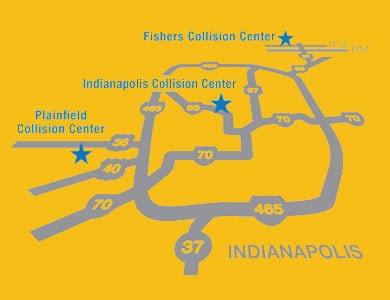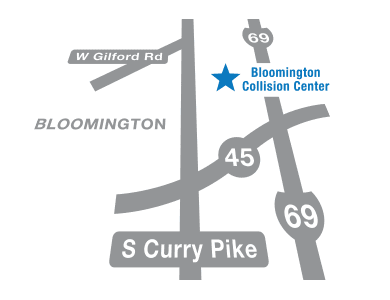
If the unimaginable has happened, and you find yourself in a collision, don’t worry. Our team at Andy Mohr Collision Center is here to help all our friends in the Plainfield, Indianapolis, Fishers, and Bloomington, Indiana, areas in what can be a stressful time.
If you learn the other party in the collision does not have car insurance, we’ve made this simple guide to help direct you when you’ve found yourself in this situation.
Step One: While at the Scene

The first thing you’ll want to do after pulling your car safely to the side of the road, is to call the police and report the accident. The officers will take statements from all parties involved and assist in getting the cars off the road.
While you’re waiting for the police to arrive, you’ll want to gather as much information as you can. Ask the other driver for their information. Even if they don’t have insurance, you’ll still need details such as:
- Their name
- Their contact information
- Their car’s make and model
- Their license plate number
You’ll also want to take pictures of the scene and get the badge number of the responding officer for when you go to report the collision to your insurance provider.
If you are experiencing any pain or discomfort following the collision, you should make sure to head to the hospital or your local urgent care, as injuries left untreated can cause larger problems over time.
Step Two: Report the Collision to Your Insurance Provider
Next you should report the collision to your own insurance company. This allows you to see how your coverage might apply. This is the first step you should take after an accident, regardless of whether the other party has insurance or not. Every insurance company has their own deadline of when to report uninsured claims, so the sooner you report, the better.
Either call the number on your insurance card, or go online to report your collision, this will depend on your provider. You’ll need information you collected from the collision site, such as:
- Your policy number
- The date, time, and location of the collision
- A brief explanation of the collision
- The contact information of the other party
- The name and badge number of the responding officer
From here, your insurance will get in contact with the other party and the police to collect any information they may have. From there, most companies will schedule an appointment to get your car inspected for damages and give a repair estimate.
Step Three: Get Your Repair Estimate

When you arrive at our collision center for your repair estimate, our ASE-certified mechanics will examine every inch of your car. The technician will go so far as to remove your side panels to ensure there is no underlying damage to the frame or any mechanical components of your vehicle.
The amount of time an inspection takes depends on the condition of your vehicle. Factors that determine this can include:
- If your car has to be towed and has severe damage, the estimate inspection could take as long as a couple of days.
- If there has been significant damage to either the body or the mechanical components of your vehicle, but it is still drivable, your estimate inspection could take longer than 30 minutes.
- Lesser damage, like dents and scrapes, with no mechanical damage could take as little as 15 minutes.
Once your vehicle has been inspected, a claims adjuster will calculate the cost of the repairs, labor, and parts. The adjuster will submit their report to your insurance provider and coverage will be allotted. After that, you’re free to give us the go ahead to order whatever parts you need, and we’ll get started.
Step Four: Getting Your Repairs at Our Collision Center
When you step into our collision center, you are our top priority. We’ll work with local tow services to make sure your vehicle gets here safe and sound. We’ll provide you with all the information you need to file your insurance claim. We’ll even help get you set up with a rental car while you’re waiting for your car’s repairs to finish.
We offer a variety of collision repair services at our full-service collision center. Our completion rates are guaranteed, and our repairs come with a limited lifetime warranty, so you can rest easy when you leave your vehicle with us.
Step Five: Look to the Future

Once your car has been repaired and taken home from the shop, it’s time to think about the future. There are a few different routes that you could go down here.
You could add some collision coverage to your existing insurance plan, this would ensure that your insurance company will pay any automotive repair damages that are incurred by an uninsured driver. It’s important to remember that it often won’t cover medical costs.
You should also look into uninsured/underinsured drive coverage from your insurance provider. This kind of coverage is required in some states, but not others. In Indiana, this coverage is automatically included, unless given explicit written rejection, so you likely already have it. If you like, you can increase this coverage with your provider.
If you were injured in the collision, make sure you heed the advice of ay medical professionals who treated you after the accident. Focus on healing and moving forward without fear. If you feel as though the collision has unduly affected your life, you can also pursue legal action against the other party in the accident through local legal counsel.
Contact us at the Andy Mohr Collision Center for your appointment!
We understand that experiencing a collision can be tough, and we’re here to do everything we can to make this process smooth and simple. The team at Andy Mohr Collision Center will get your car looking and running as close to new as possible.
You can call us, fill out our scheduling form online, or just stop on by for an appointment. Our expert technicians have plenty of experience helping the drivers in Bloomington, Fishers, Indy, and Plainfield, IN, to recover from car accidents.
After you’ve called the police and your insurance company, get in touch with us today!
Related Posts
How to Get a Car Repair Estimate
How Does a Car Insurance Deductible Work?
What to Expect from Appraisals After an Accident


